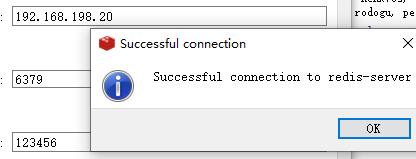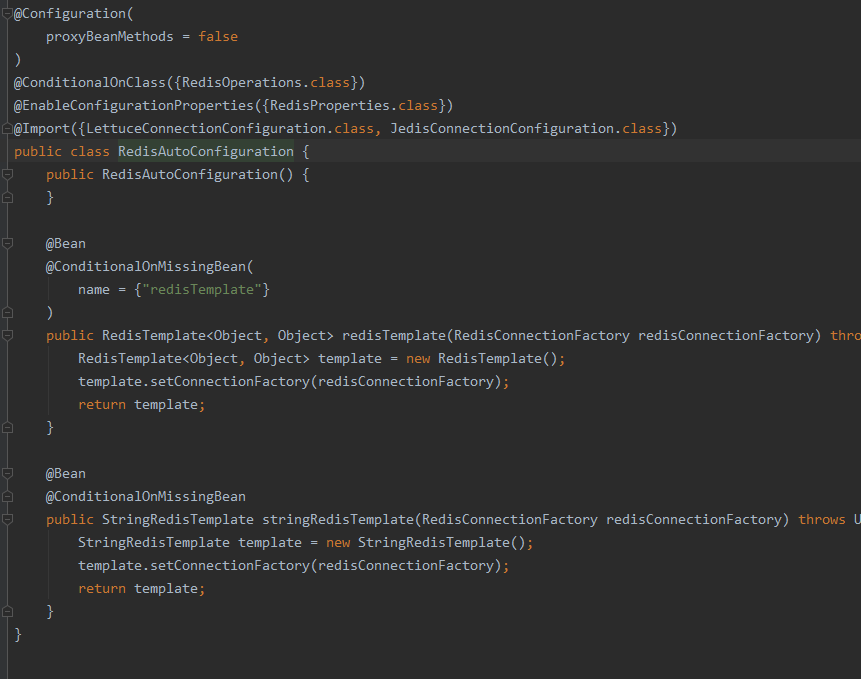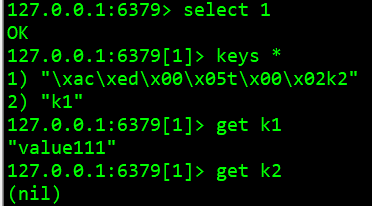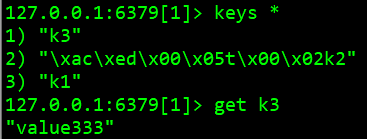这里使用自定义的Redis配置文件来使用Dokcer启动Redis。


[root@centos7 redis6]# docker run -d -v /root/redis6/redis.conf:/usr/local/etc/redis/redis.conf --name redis-v6.0.8 -p 6379:6379 redis:6.0.8 redis-server /usr/local/etc/redis/redis.conf
c9ce5b9c398e37c75e7909a54deacbb9bb3d2f5cfe726ac4bb129d434f5af411
[root@centos7 redis6]# docker ps
CONTAINER ID IMAGE COMMAND CREATED STATUS PORTS NAMES
c9ce5b9c398e redis:6.0.8 "docker-entrypoint.s…" 6 seconds ago Up 4 seconds 0.0.0.0:6379->6379/tcp redis-v6.0.8一、SpringBoot 整合单机Redis
在 SpringBoot 中,默认集成的 Redis 就是 Spring Data Redis,默认底层的连接池使用了 lettuce ,开发者可以自行修改为自己的熟悉的,例如 Jedis。
Spring Data Redis 针对 Redis 提供了非常方便的操作模板 RedisTemplate 和 StringRedisTemplate。RedisTemplate提供了redis各种操作、异常处理及序列化,支持发布订阅等。

1、创建一个 springboot 工程,引入相关依赖包,
<!--默认使用 letture-->
<dependency>
<groupId>org.springframework.boot</groupId>
<artifactId>spring-boot-starter-data-redis</artifactId>
</dependency>
<dependency>
<groupId>org.springframework.boot</groupId>
<artifactId>spring-boot-starter-web</artifactId>
</dependency>
<dependency>
<groupId>org.apache.commons</groupId>
<artifactId>commons-pool2</artifactId>
</dependency>
==或者========
<!--使用 jedis-->
<dependency>
<groupId>org.springframework.boot</groupId>
<artifactId>spring-boot-starter-data-redis</artifactId>
<exclusions>
<exclusion>
<groupId>io.lettuce</groupId>
<artifactId>lettuce-core</artifactId>
</exclusion>
</exclusions>
</dependency>
<dependency>
<groupId>redis.clients</groupId>
<artifactId>jedis</artifactId>
</dependency>主要就是引入了 Spring Data Redis + 连接池。
2、在application.properties配置文件中配置redis:
server.port=8088
# Redis 的基本信息
spring.redis.host=192.168.xxx.xxx
spring.redis.port=6379
spring.redis.password=xxxxxx
spring.redis.database=1
# 连接池信息
spring.redis.lettuce.pool.min-idle=5
spring.redis.lettuce.pool.max-idle=10
spring.redis.lettuce.pool.max-active=8
spring.redis.lettuce.pool.max-wait=1ms
spring.redis.lettuce.shutdown-timeout=100ms引入了 Spring Data Redis,配置了 Redis 的基本信息,此时,自动化配置就会生效。看一下SpringBoot 中的自动配置类 RedisAutoConfiguration。
其中 StringRedisTemplate 是 RedisTemplate 的子类,两个的方法基本一致,不同之处主要体现在操作的数据类型不同。RedisTemplate是操作对象,StringRedisTemplate是操作字符串。项目中根据业务使用他们都可以操作Redis。

3、测试操作一下String类型数据:
@RestController
public class RedisControlller {
@Autowired
private StringRedisTemplate stringRedisTemplate;
@Autowired
private RedisTemplate redisTemplate;
@GetMapping("/set")
public void set(){
ValueOperations<String, String> opsForValue1 = stringRedisTemplate.opsForValue();
opsForValue1.set("k1", "value111");
ValueOperations<String, Object> opsForValue2 = redisTemplate.opsForValue();
opsForValue2.set("k2", "value222");
}
@GetMapping("/get")
public String get(){
ValueOperations<String, String> opsForValue1 = stringRedisTemplate.opsForValue();
String v1 = opsForValue1.get("k1");
ValueOperations<String, Object> opsForValue2 = redisTemplate.opsForValue();
Object v2 = opsForValue2.get("k2");
return v1 + "==" + v2;
}
}

![]()
这是对 key和value进行序列化之后的结果。通过代码RedisTemplate获取是正常的。这是因为这两者序列化方案不同
- RedisTemplate 中,默认的序列化方案是 JdkSerializationRedisSerializer 。
- StringRedisTemplate 中,默认的序列化方案是 StringRedisSerializer 。默认情况下,前面不会有前缀。
因此,如果使用 StringRedisTemplate ,默认情况下,前面不会有前缀。开发者也可以自行修改 RedisTemplate 中的序列化方案。
redisTemplate.setKeySerializer(new StringRedisSerializer());
redisTemplate.setValueSerializer(new StringRedisSerializer());
ValueOperations<String, Object> opsForValue2 = redisTemplate.opsForValue();
opsForValue2 = opsForValue2;
opsForValue2.set("k3", "value333");
针对其他类型的序列化方案修改同理。
针对其他具体数据类型的操作,首先需要获取相应数据类型的操作方法是 opsForXXX,然后对数据进行操作方法,和命令对数据操作类似。比如:


整合单机Redis就这么简单的搞定了。
二、整合Jedis
依赖上面已经说明了。配置同上,其实 RedisTemplate就可以依赖注入使用了。
如果我们想使用 JedisPool来操作,就需要注入bean了。
1、在application.yml配置文件中,自定义配置项
# 自定义配置项
jedis:
host: 192.168.xxx.xxx
password: xxxxxx
port: 6379
timeout: 2000
maxTotal: 15 # 最大连接数
maxIdle: 10 # 最大空闲连接
minIdle: 5 # 最小空闲连接
maxWaitMillis: 10000 # 获取连接最大等待时间
testOnBorrow: true # 获取连接时检测是否可用2、创建配置类
@Configuration
public class JedisConfig extends CachingConfigurerSupport {
private Logger logger = LoggerFactory.getLogger(JedisConfig.class);
@Value("${jedis.host}")
private String host;
@Value("${jedis.port}")
private int port;
@Value("${jedis.password}")
private String password;
@Value("${jedis.timeout}")
private int timeout;
@Value("${jedis.maxIdle}")
private int maxIdle;
@Value("${jedis.minIdle}")
private int minIdle;
@Value("${jedis.maxWaitMillis}")
private long maxWaitMillis;
@Value("${jedis.testOnBorrow}")
private boolean testOnBorrow;
@Value("${jedis.maxTotal}")
private int maxTotal;
@Bean
public JedisPoolConfig jedisPoolConfig() {
JedisPoolConfig jedisPoolConfig = new JedisPoolConfig();
jedisPoolConfig.setMaxTotal(maxTotal);
jedisPoolConfig.setMaxIdle(maxIdle);
jedisPoolConfig.setMinIdle(minIdle);
jedisPoolConfig.setMaxWaitMillis(maxWaitMillis);
jedisPoolConfig.setTestOnBorrow(testOnBorrow);
return jedisPoolConfig;
}
@Bean
public JedisPool jedisPool(JedisPoolConfig jedisPoolConfig) {
logger.info("=====创建JedisPool连接池=====");
if(StringUtils.isNotEmpty(password)) {
return new JedisPool(jedisPoolConfig, host, port, timeout, password);
}
return new JedisPool(jedisPoolConfig, host, port, timeout);
}
// 这两个都可以
// @Bean
// public JedisPool jedisPoolFactory() {
// JedisPoolConfig jedisPoolConfig = new JedisPoolConfig();
// jedisPoolConfig.setMaxTotal(maxTotal);
// jedisPoolConfig.setMaxIdle(maxIdle);
// jedisPoolConfig.setMinIdle(minIdle);
// jedisPoolConfig.setMaxWaitMillis(maxWaitMillis);
// jedisPoolConfig.setTestOnBorrow(testOnBorrow);
// JedisPool jedisPool = new JedisPool(jedisPoolConfig, host, port, timeout, password);
// return jedisPool;
// }
}3、愉快的使用
// 简单实现 mq消息
@Component
public class ListMq {
public final static String LIST_MQ = "LIST_MQ:";
@Autowired
private JedisPool jedisPool;
/*消费者接受消息*/
public List<String> get(String key) {
Jedis jedis = null;
try {
jedis = jedisPool.getResource();
return jedis.brpop(0,LIST_MQ +key);
} catch (Exception e) {
throw new RuntimeException("接受消息失败!e=" + e);
} finally {
if (jedis != null){
jedis.close();
}
}
}
/*生产者发送消息*/
public void put(String key, String message) {
Jedis jedis = null;
try {
jedis = jedisPool.getResource();
jedis.lpush(LIST_MQ +key,message);
} catch (Exception e) {
throw new RuntimeException("发送消息失败!");
} finally {
if (jedis != null){
jedis.close();
}
}
}
}—— Stay Hungry. Stay Foolish. 求知若饥,虚心若愚。
最后
以上就是喜悦樱桃最近收集整理的关于SpringBoot 整合Redis的全部内容,更多相关SpringBoot内容请搜索靠谱客的其他文章。
![[Database] Redis (1)](https://file2.kaopuke.com:8081/files_image/reation/bcimg14.png)







发表评论 取消回复